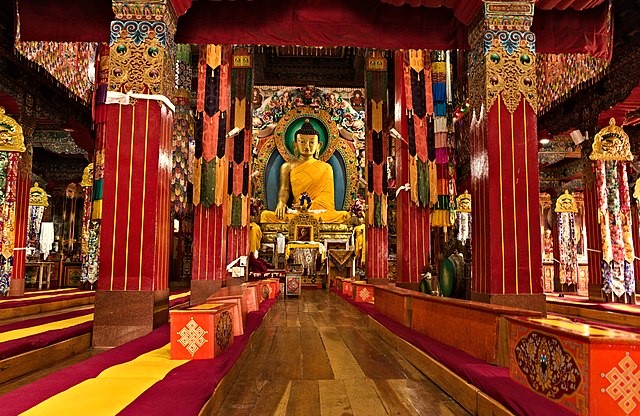Tawang Monastery stands as a beacon of spirituality and cultural heritage. Perched at an altitude of about 3,000 meters, this magnificent monastery is not just a place of worship but a symbol of the rich Tibetan Buddhist culture that thrives in the region. Often referred to as the monastery in Tawang, it is the largest monastery in India and the second largest in the world.
Historical Significance
The Tawang Monastery was founded in 1680 by Mera Lama Lodre Gyatso, who was a disciple of the great 5th Dalai Lama. The monastery played a pivotal role in the spread of Buddhism in the region and has since been a center for monastic education and spiritual learning. The architecture of the monastery is a stunning representation of Tibetan style, characterized by intricate woodwork, colorful murals, and majestic prayer halls.
Architectural Marvel
When you approach the monastery in Tawang, you are greeted by its impressive structure that overlooks the Tawang River Valley. The monastery complex encompasses several buildings, including the main temple, assembly hall, and numerous rooms for monks. The main temple houses a colossal statue of Buddha, which stands at an impressive height of 18 feet. This statue, adorned with beautiful thangkas (traditional Tibetan paintings), is a sight to behold and serves as a focal point for visitors and devotees alike.
The intricate carvings and colorful frescoes that adorn the walls depict various scenes from Buddhist mythology, providing insight into the teachings of Buddha and the history of Tibetan Buddhism. The architecture itself tells a story, harmonizing with the surrounding landscape, making it a serene place for meditation and reflection.
Cultural Hub
The Tawang Monastery is not just a religious site; it is a cultural hub that hosts various festivals and events throughout the year. One of the most significant celebrations is the Losar, the Tibetan New Year, which usually falls in February or March. During this time, the monastery is abuzz with activity as monks perform traditional rituals, and locals participate in vibrant cultural programs. Visitors are encouraged to join in the festivities, making it a unique opportunity to experience the rich tapestry of Tibetan culture.
In addition to Losar, the monastery in Tawang also observes other important Buddhist festivals, such as Buddha Purnima and Choskar. These events attract not only locals but also tourists from all over the world, eager to immerse themselves in the spiritual ambiance of the monastery.
Spiritual Retreat
For those seeking solace and spiritual enlightenment, the monastery Tawang offers various meditation programs and retreats. Monks at the monastery are always ready to guide visitors through meditation sessions that focus on mindfulness and self-awareness. The tranquil surroundings of Tawang provide an ideal backdrop for introspection and spiritual growth.
Visitors can participate in daily prayers and rituals, experiencing the profound peace that resonates within the monastery walls. The chanting of mantras and the ringing of prayer bells create an atmosphere that feels almost transcendent, allowing guests to connect with their inner selves.
Scenic Beauty
The location of the Tawang Monastery adds to its allure. Surrounded by snow-capped mountains and lush greenery, the monastery offers stunning views of the Himalayas. The journey to Tawang is equally captivating, with winding roads that provide glimpses of charming villages, cascading waterfalls, and dense forests. Travelers often find themselves enchanted by the beauty of nature, making their pilgrimage to the monastery an unforgettable experience.
The best time to visit the monastery in Tawang is during the summer months from April to October when the weather is pleasant and the landscape is vibrant. However, winter also has its own charm, as the monastery becomes a serene haven covered in a blanket of snow.
Accessibility
Reaching the Tawang Monastery involves a journey that can be both adventurous and rewarding. The nearest airport is in Tezpur, Assam, and from there, visitors can take a taxi or bus to Tawang. The drive is long but filled with picturesque scenery. Additionally, there are shared taxis available from various towns in Arunachal Pradesh, making it accessible for budget travelers.
While the journey may require some effort, the experience of visiting this remarkable monastery is well worth it. The warm hospitality of the locals and the serene environment of Tawang create a welcoming atmosphere for all who venture here.
Conservation Efforts
Recognizing the importance of preserving the cultural and historical significance of the Tawang Monastery, various initiatives have been undertaken to maintain its integrity. The Indian government, in collaboration with local authorities and organizations, has implemented measures to protect the site from environmental degradation and to promote sustainable tourism.
These efforts not only aim to safeguard the monastery but also to enhance the overall experience for visitors, ensuring that the rich heritage of Tawang is preserved for future generations.
Conclusion
The Tawang Monastery is a treasure trove of spirituality, culture, and natural beauty. Whether you are a devoted Buddhist seeking enlightenment, a traveler looking for adventure, or simply someone wanting to experience the tranquility of the Himalayas, the monastery Tawang offers something for everyone.
As you explore the vast halls filled with centuries of wisdom and witness the daily rituals that have been practiced for generations, you’ll understand why this monastery is considered one of the most important spiritual centers in India. A visit to Tawang is not just a journey to a place; it’s a journey of the soul. So, pack your bags and prepare for an unforgettable experience in the heart of Arunachal Pradesh.





Comments